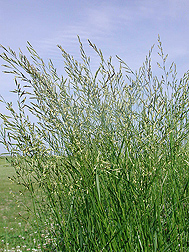This page has been archived and is being provided for reference purposes only. The page is no longer being updated, and therefore, links on the page may be invalid.
| Read the magazine story to find out more. |
|
|
Dairy Farmer Finds Unusual Forage Grass
By Don ComisMarch 15, 2011
A U.S. Department of Agriculture (USDA) grass breeder has rediscovered a forage grass that seems just right for today's intensive rotational grazing.
A farmer's report of an unusual forage grass led Michael Casler, an Agricultural Research Service (ARS) geneticist at the agency's U.S. Dairy Forage Research Center in Madison, Wis., to identify the grass as meadow fescue. Meadow fescue has been long forgotten, although it was popular after being introduced about 50 to 60 years before tall fescue.
ARS is USDA's principal intramural scientific research agency.
Casler has developed a new variety of meadow fescue called Hidden Valley, and its seed is being grown for future release.
Non-toxic fungi called endophytes live inside meadow fescue, helping it survive heat, drought and pests. Unlike the toxic endophytes that inhabit many commercial varieties of tall fescue and ryegrass, meadow fescue does not poison livestock.
Charles Opitz found the grass growing in the deep shade of a remnant oak savannah on his dairy farm near Mineral Point, Wis. He reported that the cows love it and produce more milk when they eat it. Casler used DNA markers to identify Opitz's find.
Meadow fescue is very winter-hardy and persistent, having survived decades of farming. It emerged from oak savannah refuges to dominate many pastures in the Midwest's driftless region, named for its lack of glacial drift, the material left behind by retreating continental glaciers.
Casler and his colleagues have since found the plant on more than 300 farms in the driftless region of Wisconsin, Iowa and Minnesota. Geoffrey Brink, an ARS agronomist working with Casler, discovered that meadow fescue is 4 to 7 percent more digestible than other cool-season grasses dominant in the United States.
In another study, meadow fescue had a nutritional forage quality advantage over tall fescue and orchardgrass that may compensate for its slightly lower annual yield further north, as reported in the Agronomy Journal. Also, the yield gap begins to close with the frequent harvesting involved in intensive grazing.
Read more about the research in the March 2011issue of Agricultural Research magazine.

